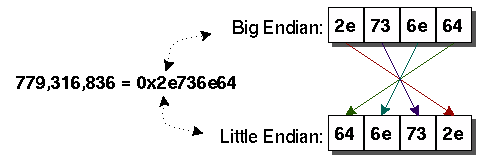
Most data types are larger than one byte. On big endian computers, the first byte encountered in the data storage area is the most significant byte, while on a little endian computer, the first byte encountered in the data storage area is the least significant byte. So if you think you are reading one type, but are actually reading another type, you will get a completely different number!
Take for example the number 779,316,836 as a 32-bit number, or an 4-byte number. In hexadecimal notation, this number is equivalent to 0x2e736e64. Pairs of hexadecimal digits are equivalent to one byte of storage area (each hexadecimal digit is equal to half a byte, or 4 bits). On a computer, this number can be stored in two ways according to the endianess of the computer:

Note that the bits inside the byte do not change their ordering. See the WAVE soundfile format which has an example of the bytes found in a soundfile and how they are interpreted as little endian numbers.